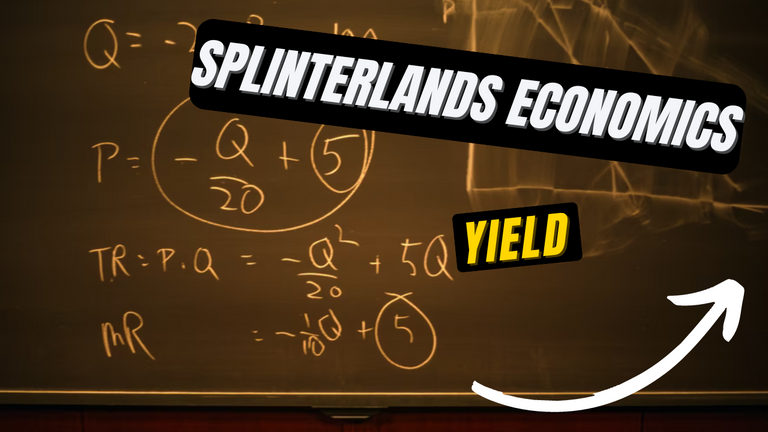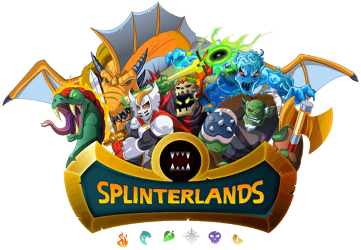Hello everyone! We are back again today with another edition of Splinterland Economics - a series in which we introduce a basic economic concept and then apply it to Splinterlands. If this is your first time reading, just to tell you a little bit about myself: my day job is in an unrelated area but I consider myself a little bit of economics nerd - I read a little (or maybe way, way) more news than I should, double majored in econ, and am obsessed with optimization. I love the way Splinterlands is equal parts card game and resource allocation game. My goal with these articles is to share a little bit of what I know with you all.
Our subject today comes up a lot in finance and is something that many investors try to maximize. While it shares a name with a common traffic sign, it also describes a key attribute of many assets and understanding what it means can make a world of difference when it comes to your financial decisions. Today, we will be talking about Yield!

What is Yield?

Yield is the amount of money that you earn from owning that asset. Yield is usually expressed as a rate - most commonly, as the percentage of the asset's cost which is returned annually. Do note that when we say "yield" we generally are referring to the cash flow generated by the asset, and that the number usually does not include changes to the asset's underlying value. That can change depending on who is doing the calculations though, so be sure to double check if you are getting those numbers from somebody else!
Some common examples of cash flows are bond payments from holding bonds, dividends from stocks, or rental payments from holding investment properties. In order to get a rough yield calculation, you can determine how much money you can earn from that asset in a year and divide it by its price. The great thing about assets with yield is that since they are giving you some amount of cash flowing in, you can do whatever you want with that additional money while still holding on to that original asset. I personally am a big fan of compounding it back into even more of that asset giving me yield, but depending on the situation you may choose to invest in alternative items or even just use it as some extra spending money.
In general, higher yields are obviously better - who doesn't want more money? Holding assets with higher yields will often give you a greater margin of safety on those investments since the higher the yield, the sooner you will be able to recoup the money that you spent on that investment. But do remember that markets are going to market and that other people are doing their best to allocate their capital efficiently just like you - if something has a high yield then there may be a good reason for it. For example, the yield may be about to decrease, the value of the asset could be expected to drop in the near future, or holding the asset may come with other additional complications. So as always, Do Your Own Research!
How do we apply it to Splinterlands?
In Splinterlands nearly every asset will have a yield, and some will even have multiple different ones which you have to choose between. For example, cards can produce a yield from using them to play in ranked battles, brawls and tournaments. But cards may also be instead rented out for a different yield depending on the market rental rate. In cases like these, being able to evaluate the different yields and identify which ones are the largest may help you to make a better decision about how to utilize your resources. Other examples of assets with yields are node licenses (which produce vouchers, with SPS soon to follow) and SPS/DEC/vouchers held in a liquidity pool.
Splinterlands operates in the crypto world, and that can make calculating yields tricky when the prices of various cryptos fluctuate. However, you can still estimate yields by making your best guesses and/or making your calculations in terms of a specific currency. For example, you can record how much DEC you paid for a collection or individual card and keep track of how much you earn in terms of DEC over time. In a case with mixed currencies such as nodes, you can determine how how much you paid for a node in the currency of your choice (perhaps convert the combination of SPS and vouchers to all SPS, or USD), and perform a similar conversion to the cash flows you receive for holding (and soon operating) that node.
Splinterlands and crypto in general tend to have higher yields than in the real world. Joining this community was my first experience in crypto, and it was a little bit of a shock to see numbers like 20%, 30% or even 100% or more on yields for certain types of assets - on real world assets, anything over 10% is great! There is a tradeoff though, as assets here are quite a bit more volatile in price and prone to extreme fluctuations in value. Anyone who bought into the ecosystem late last year is likely to be sitting on quite a bit of losses, for instance.
Why should we care?
Do keep in mind that when it comes to investing, yield is just half of the picture. The other half is appreciation. While it is all well and good to chase high yields, it is equally important to recognize that a high yield really serves two purposes. First, to show us the possibility that an asset is undervalued and that you are getting a good deal. And second, to alert us to the fact that there is potentially some risky aspect to the asset. So as always, do your due diligence. Maybe there is a reason for that high yield, but it is also possible that you are simply ahead of the curve and that you have found a way to increase your wealth!
In both Splinterlands and our real world investments, the goal, for most of us at least, is to maximize the total return of our assets. Yield is a large part of that, and understanding what it is and how to calculate it can help us to make better decisions with our money and resources.
Thank you so much for reading all the way to the end. Interested in seeing some more of my writing in the future? Be sure to give me a follow! In the meantime, if you'd like to see some of my recent posts:
Splinterlands Economics: Value - A look into the concept of value, and how we can apply it to our advantage in Splinterlands.
Flying Above the Carnage - Using Dragons in Battle! - Last week's battle challenge, featuring Dragons!
Splinterlands Economics: Business Cycles - An introduction to buisiness cycles, and how understanding them can help us out in Splinterlands.
Thinking about giving Splinterlands a try but haven't signed up yet? Feel free to use my referral link: https://splinterlands.com?ref=bteim, and be sure to reach out to me if you have any questions!
All images used in this article are open source and obtained from Pixabay or Unsplash. Thumbnails borrowed with permission from the Splinterlands team or made in Canva.




